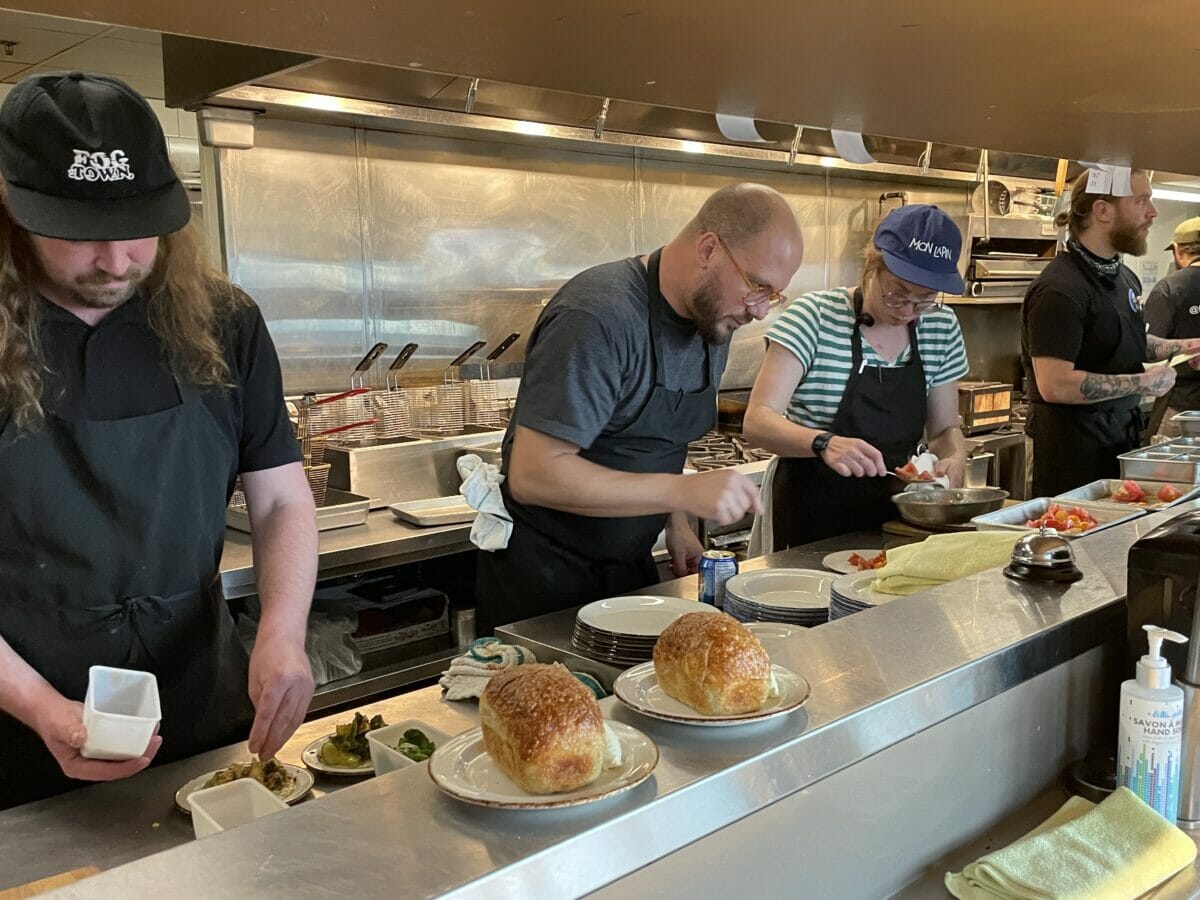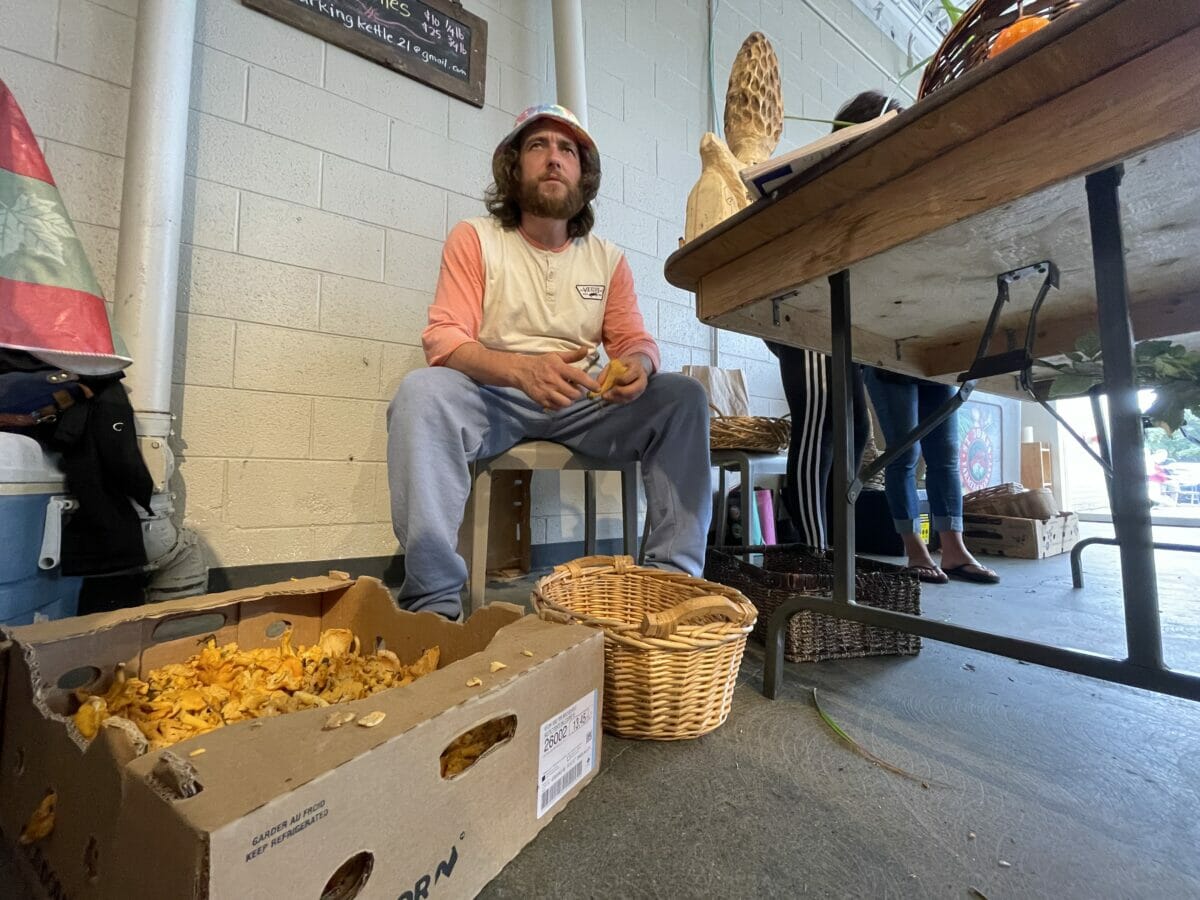How One Chef is Embracing Seasonal Food with Sub-Sea Foraging
In Newfoundland, where the ocean is at your doorstep, seasonal food goes far beyond what’s growing in the garden.
How One Chef is Embracing Seasonal Food with Sub-Sea Foraging
In Newfoundland, where the ocean is at your doorstep, seasonal food goes far beyond what’s growing in the garden.

Chef Matthew Swift (center) prepares a seasonal menu at Terre.by Emily Baron Cadloff.
When I arrive for dinner at Terre, chef and owner Matthew Swift is apologetic. There are no scallops on the menu tonight. There’s been a lot of rain in Newfoundland lately, he explains, so his scallop harvester hasn’t been able to get out on the water.
It’s not an unusual situation for Swift, who writes a new menu nearly every day, in a style he refers to as “reactionary.” But the dramatic swings in what’s available—and when—are unlike anything he’s ever worked with before.
Swift and his wife moved to St. John’s, the capital of Newfoundland and Labrador, in 2017. Before that, the chef had served stints in Toronto and Montreal’s renowned Joe Beef, but after a single visit to the Atlantic province, he was sold. The couple moved east and opened up Terre, following a truly seasonal ethos—although he shies away from using terms such as farm to table, fearing there’s too much pretension associated there.
“In restaurants, you have a lot of claims being made—that things are watered with virgin’s tears from Mount Olympus and only harvested in the full moon. Really? Then how do you have enough of that to serve 50 people every night?” Swift says with a laugh. “I try not to make too many of those claims.”
Instead, Swift has quietly devoted himself to showcasing local food. Super local.
St. John’s is home to about 112,000 people, and the entire province of Newfoundland and Labrador has a population of just more than half a million people in an area that can be driven in a single day. In the small-ish city, relationships between chefs and suppliers are looser, more spontaneous and not just in the ingredients available. In Montreal, Swift relied on regular deliveries of meat and produce, trucks pulling up to the restaurant laden with food each week on a consistent schedule. In St. John’s, things are a little different. “I might have to drive to pick up [produce] myself or time the delivery for when their dad’s in town to see the doctor, so they have to come this way for an appointment. That’s my supply chain,” says Swift.
Working within a hyper-local supply system also means that Swift gets to connect with people outside of a traditional food system. For instance, he gets many of his mushrooms, berries, plums and other greens from forager Shawn Dawson, who says he’s thrilled with the revitalized interest in local food. “I was trying to sell stinging nettles and Japanese knotweed 10 years ago, and people thought it was literally insane,” says Dawson. But now, with the arrival of Swift and other like-minded local-first restaurateurs, diners are more likely to find the ingredients on menus.

“People think of [foraging] as a famine pastime or even a nuisance. But there’s so much bounty all around us. Everyone’s backyard in Newfoundland has something to eat,” says Dawson. And that extends pretty far when your backyard butts up against the Atlantic ocean. Swift doesn’t only work with foragers in the forests and trails. He also sources from aquatic foragers, such as harvester Timothy Ball, who brings in lobster, crab, sea cucumbers, scallops, sea urchins and more.
A diver, Ball forages the sea by hand, methodically diving down and individually choosing edible treasures from the ocean floor. Just like Dawson has methods for foraging mushrooms—never take more than half of a patch at any time, never rip up from the base and destroy the roots—Ball is careful about what and how much he picks. He checks the size of each scallop, for instance, so he doesn’t grab any that are too young. He also harvests shellfish and seafood without dragging a net, which he says can destroy some of the ocean floor habitat.
“We’re picking up scallops and moving on and not upsetting rocks and kelp the way a drag would,” says Ball. Even with the slower pace, Ball says his catch rates are pretty close to what larger boats might bring in with nets. “You can end up with about 100 pounds of scallop from a drag. I can do between 50 and 60 pounds a day, depending on the depth, and in this operation, there’s two of us diving.”
Of course, relying on foraging and harvesting means there are uncontrollable limitations on what you can get—and when. Weather or a mechanical failure can cancel a trip. Plus, Ball can only go out diving a few days at a time. “My goal is to dive for about three or four days and take a break, because multiple dives over multiple days can play havoc with your system, and your body is the tool when you do this,” he says. By necessity, the give and take between chef and harvester has to be fluid and trustworthy. If Ball can’t deliver on a Thursday, he knows that will impact Swift’s Friday night bottom line.
Working within seasonal shifts means there will always be a fallow season, a dry season. “There are these moments in early March where the bigger question of food sovereignty and food security come up, because, in those moments, there’s absolutely nothing here,” says Swift.
In those moments, the fix isn’t going to be a quick tweak to the menu. Some chefs might throw in the towel and call up some traditional restaurant suppliers. For Swift, it’s an opportunity to stick to his guns and lean into the creativity inherent in what he does. He says that’s when his restaurant actually prompts a conversation with its guests. “We all love this idea of the ephemeral thing, the nicest scallop you’ve ever seen. We have several products that are the nicest ones you’ve ever seen. But there’s an ephemeral nature to it,” he says.
At the end of my dinner, Swift asks me to come back for a second night, just for a quick bite. The scallops are coming tomorrow and I simply have to try them.
Follow us
This work is licensed under a Creative Commons Attribution-NoDerivatives 4.0 International License.
Want to republish a Modern Farmer story?
We are happy for Modern Farmer stories to be shared, and encourage you to republish our articles for your audience. When doing so, we ask that you follow these guidelines:
Please credit us and our writers
For the author byline, please use “Author Name, Modern Farmer.” At the top of our stories, if on the web, please include this text and link: “This story was originally published by Modern Farmer.”
Please make sure to include a link back to either our home page or the article URL.
At the bottom of the story, please include the following text:
“Modern Farmer is a nonprofit initiative dedicated to raising awareness and catalyzing action at the intersection of food, agriculture, and society. Read more at <link>Modern Farmer</link>.”
Use our widget
We’d like to be able to track our stories, so we ask that if you republish our content, you do so using our widget (located on the left hand side of the article). The HTML code has a built-in tracker that tells us the data and domain where the story was published, as well as view counts.
Check the image requirements
It’s your responsibility to confirm you're licensed to republish images in our articles. Some images, such as those from commercial providers, don't allow their images to be republished without permission or payment. Copyright terms are generally listed in the image caption and attribution. You are welcome to omit our images or substitute with your own. Charts and interactive graphics follow the same rules.
Don’t change too much. Or, ask us first.
Articles must be republished in their entirety. It’s okay to change references to time (“today” to “yesterday”) or location (“Iowa City, IA” to “here”). But please keep everything else the same.
If you feel strongly that a more material edit needs to be made, get in touch with us at [email protected]. We’re happy to discuss it with the original author, but we must have prior approval for changes before publication.
Special cases
Extracts. You may run the first few lines or paragraphs of the article and then say: “Read the full article at Modern Farmer” with a link back to the original article.
Quotes. You may quote authors provided you include a link back to the article URL.
Translations. These require writer approval. To inquire about translation of a Modern Farmer article, contact us at [email protected]
Signed consent / copyright release forms. These are not required, provided you are following these guidelines.
Print. Articles can be republished in print under these same rules, with the exception that you do not need to include the links.
Tag us
When sharing the story on social media, please tag us using the following: - Twitter (@ModFarm) - Facebook (@ModernFarmerMedia) - Instagram (@modfarm)
Use our content respectfully
Modern Farmer is a nonprofit and as such we share our content for free and in good faith in order to reach new audiences. Respectfully,
No selling ads against our stories. It’s okay to put our stories on pages with ads.
Don’t republish our material wholesale, or automatically; you need to select stories to be republished individually.
You have no rights to sell, license, syndicate, or otherwise represent yourself as the authorized owner of our material to any third parties. This means that you cannot actively publish or submit our work for syndication to third party platforms or apps like Apple News or Google News. We understand that publishers cannot fully control when certain third parties automatically summarize or crawl content from publishers’ own sites.
Keep in touch
We want to hear from you if you love Modern Farmer content, have a collaboration idea, or anything else to share. As a nonprofit outlet, we work in service of our community and are always open to comments, feedback, and ideas. Contact us at [email protected].by Emily Baron Cadloff, Modern Farmer
October 31, 2022
Modern Farmer Weekly
Solutions Hub
Innovations, ideas and inspiration. Actionable solutions for a resilient food system.
ExploreExplore other topics
Share With Us
We want to hear from Modern Farmer readers who have thoughtful commentary, actionable solutions, or helpful ideas to share.
SubmitNecessary cookies are absolutely essential for the website to function properly. This category only includes cookies that ensures basic functionalities and security features of the website. These cookies do not store any personal information.
Any cookies that may not be particularly necessary for the website to function and are used specifically to collect user personal data via analytics, ads, other embedded contents are termed as non-necessary cookies.
Your articles are always so refreshing !!
Great Article, Will keep coming back!
Thanks for sharing!